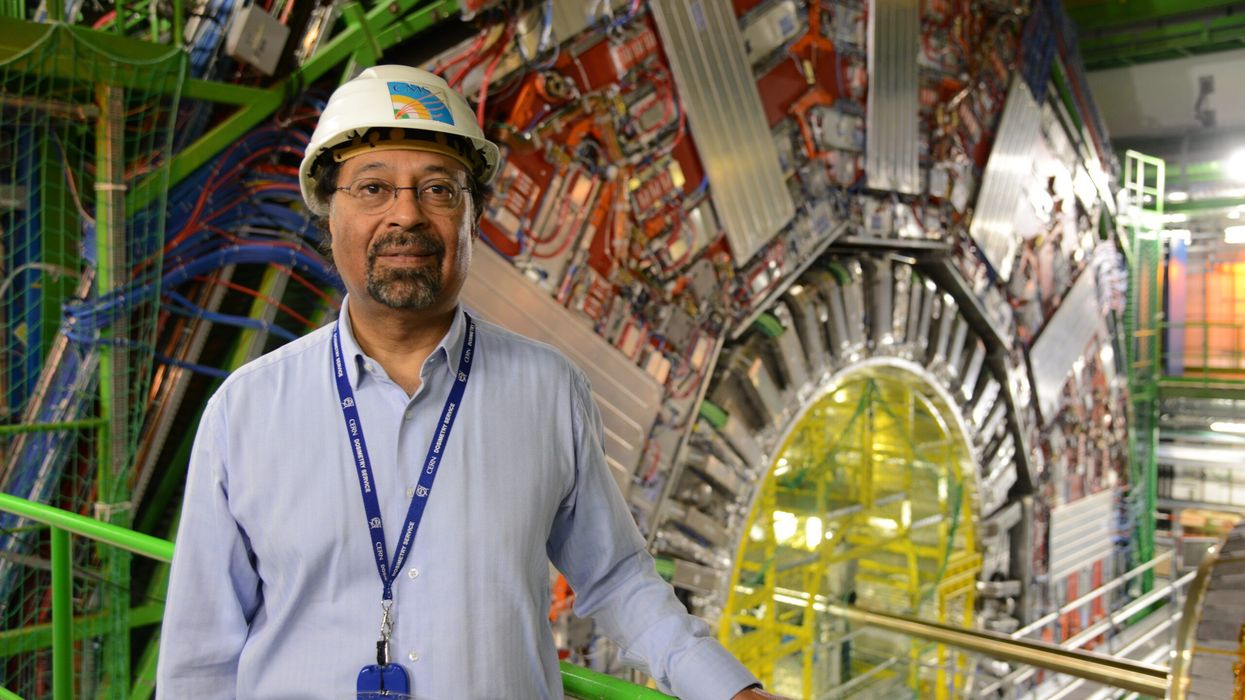THE physicist, Professor Sir Tejinder Virdee, has been given the ‘Royal Medal’, an exceptionally high honour, by the Royal Society.
Virdee is known for formulating cutting-edge experiments at the Large Hadron Collidor (LHC) in Geneva, where he lives with his wife, Vatsala.
He comes frequently to London because he remains a professor of physics at Imperial College London.
Virdee, who was born into a Sikh family in Nyeri, Kenya, on October 13, 1952, came to Britain with his family at the age of 15. He studied at King’s Norton Boys’ Grammar School in Birmingham (where he was inspired by his physics master, Howard Stockley). After taking an undergraduate degree in physics at Queen Mary College London, Virdee did his PhD at Imperial College.
He was awarded the Royal Medal at a function in London last Thursday (17) at the Royal Society’s headquarters in Carlton House Terrace, which Virdee attended with his wife and their children, Jas and Natasha.
Founded in 1660, the Royal Society is a fellowship of many of the world’s most eminent scientists, and is the oldest scientific academy in continuous existence.
Professor Sir Venkatraman Ramakrishnan, a winner of the Nobel Prize for chemistry in 2009, was president of the society from 2015-2020, the first person of Indian origin to hold the post.
Royal Medals are awarded “for the most important contributions to the advancement of ‘Natural Knowledge’ in the physical and biological sciences respectively”. Also known as the Queen’s Medals, they are awarded annually by the sovereign on the recommendation of the council of the Society. The Royal Medals were founded by King George IV in 1825.
The citation said Virdee received the Royal Medal (Physical) “for extraordinary leadership and profound impact on all phases of the monumental CMS (Compact Muon Solenoid) experiment at the CERN Large Hadron Collider [LHC], including the crucial discovery of the Higgs Boson through its decays to two photons”.
Virdee with his wife Vatsala, son Jas and daughter Natasha at the award ceremonyVirdee responded: “It is an honour and privilege to receive the Royal Medal and be associated with an advance in science that is the discovery of the Higgs Boson by the ATLAS and CMS experiments.
“The medal not only celebrates fundamental science, but also recognises the audacious undertaking of the many scientists, engineers and technicians from around the world who, over many years, came together to build and operate the powerful experiment that is CMS.
“This award provides a further push to continue probing the secrets of nature. Furthermore, it will allow me to continue efforts in motivating secondary school students in sub-Saharan countries to pursue the study of fundamental physics.”
The Higgs Boson takes its name from the British theoretical physicist, Peter Higgs, and the Indian legend, Satyendra Nath Bose – the latter had collaborated with Albert Einstein.
At CERN in Geneva, where Virdee has a central role, some 2,500 scientists are working on the biggest collaborative experiment the world has ever seen. They connect with 10,000 other scientists from universities and institutions all over the world. Together they are seeking what Virdee calls “the holy grail of physics” – an equation that would take “the new physics” beyond Isaac Newton and Einstein and provide one equation that would govern all of physics.
“The standard model (of physics) that we know is incomplete,” Virdee has explained to Eastern Eye. “It works brilliantly for a visible matters like stars and how stars burn.”
But visible matter accounts for barely five per cent of the universe. “We know there is 25 per cent of ‘dark matter’ and about 75 per cent ‘dark energy’ – and we don’t have a clue what these are.”
Scientists also seek a fuller understanding of how the universe came into being nearly 14 billion years ago. The significance of the Higgs Boson particles is they are thought to have been present when the universe was born with a ‘Big Bang’.
“Understand the Higgs Boson and you understand more about how the universe works,” is the underlying philosophy.
The Higgs Boson has been artificially created by getting protons to collide with each other at very high speeds inside the LHC, located inside in a tunnel 27 km (17 miles) in circumference and as deep as 175m (574 ft) beneath the France-Switzerland border near Geneva.
Virdee with the Royal Society president Sir Adrian SmithIt took 30 years of experiments to find the Higgs Boson, which was proposed by Peter Higgs and other physicists in the early 1960s.
Virdee was elected Fellow of the Royal Society in 2012 and was given a knighthood in 2014. He is considered a founding father of the CMS collaboration at the LHC, and has played a major role in all phases of the experiment, from conception and design, through construction to the extraction of science that have already lasted over 30 years.
He was involved in almost all the major choices and decisions for the experiment, and pioneered some of the techniques used in its calorimeters crucial for the discovery of the Higgs Boson, announced by the CMS experiment in July 2012, along with the ATLAS experiment.
His current work involves studies of the newly found Higgs Boson, search for physics beyond the standard model of particle physics and the design of the upgrades of the CMS detector.
Virdee said he was excited by “the search for new physics”.
“There is much experimental evidence for the existence of physics beyond that encapsulated in the standard model of particle physics, a most successful theory of the visible matter in our universe.”
He elaborated: “The CMS experiment is entering the era of precision Higgs physics that will shed light on new physics.”
Virdee set out how “particle physics is the centuries-old effort to understand the most basic elements of nature and the laws that govern them. The Large Hadron Collider collides protons, reproducing some of the fundamental particle interactions that scientists believe were taking place a fraction of a billionth of a second after the Big Bang.”
Virdee explained how fundamental research can turn into applied science, benefiting mankind.
He told Eastern Eye: “Conducting scientific research, and making progress in fundamental science allows us to get a deeper understanding of how nature works. Over the centuries, this deeper understanding has very much altered the way we live – giving us a better life.
“Fundamental science has given us paradigm-shifting technologies, such as electricity, electronics, telecommunication, medical imaging and the world wide web (www), invented some 30 years ago at CERN, and now widely used by CMS to share data around the globe. And www use is ubiquitous in commerce, scholarship, and communication.
“The discovery of the electron, the first fundamental particle with mass, discovered in 1897, and the deep understanding of its behaviour, gave us the world of semiconductor electronics, which has led to many great benefits for humankind.”













